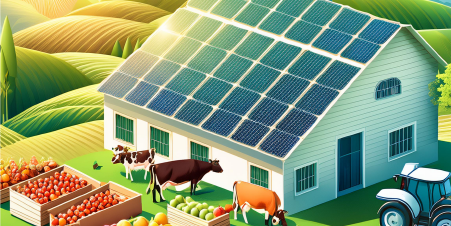
Solar power is an effective solution for reducing energy costs and boosting efficiency in agricultural processing. By harnessing the sun’s energy, small-scale farmers can
operate more sustainably and profitably. This guide will walk you through the key steps to optimize solar power for your agricultural processing needs.
1. Assessing Your Energy Needs
Before setting up a solar power system, it’s important to determine how much energy your processing activities require.
List Your Equipment: Identify the machinery you need to power, such as pasteurizers or cold storage units.
Calculate Energy Use: Check each piece of equipment’s energy consumption, typically provided in kilowatt-hours (kWh), and determine your daily energy demand based on usage hours. This calculation will guide you in choosing the right solar system size for your farm.
2. Choosing the Right Solar System for Your Farm
After determining your energy needs, you’ll need to select the appropriate solar power setup. Here’s what to consider:
Solar Panels: Choose panels that can generate enough energy based on your equipment’s total daily consumption and the average sunlight hours in your area.
Battery Storage: A battery system will store excess solar energy for use during nighttime or cloudy days, ensuring uninterrupted processing.
Inverters: Ensure you have the right inverter to convert the solar energy into usable electricity for your equipment.
3. Setting Up Your Solar System
Optimal Placement: Install solar panels in an area that gets maximum sun exposure throughout the day, avoiding shadows from trees or buildings.
Professional Installation: For safety and efficiency, hire a certified technician to connect your system to your processing equipment.
4. Maintaining Your Solar Power System
Regular maintenance ensures your solar power system operates efficiently:
Clean Panels: Dust and dirt can reduce the efficiency of your panels, so clean them at least once a month.
System Inspections: Schedule annual check-ups with a technician to ensure all components, from batteries to inverters, are functioning properly.
5. Maximizing Solar Efficiency in Agricultural Processing
To get the most out of your solar-powered system:
Use Energy-Efficient Equipment: Opt for machinery designed to consume less power, improving overall efficiency.
Timing: Run high-energy equipment during peak sunlight hours to rely more on direct solar power and less on stored energy.
6. Techwin’s Solar Solutions for Small-Scale Farmers
At Techwin Limited, we specialize in solar-powered agricultural equipment that meets the needs of small-scale farmers. Our products are designed to reduce energy costs while enhancing productivity.
Solar-Powered Pasteurizers: Ideal for dairy farmers looking to process milk and yogurt sustainably.
Solar-Powered Cold Storage: Keep your produce fresh with our solar-powered refrigeration units, minimizing post-harvest losses.
Solar Irrigation Systems: Ensure consistent water supply with our solar-powered irrigation solutions.
Conclusion
Optimizing solar power for small-scale agricultural processing is a smart way to reduce costs, increase efficiency, and contribute to sustainable farming practices. With the right setup and maintenance, you can ensure a reliable energy source for your farm.
Ready to harness solar energy for your farm? Contact Techwin Limited at +254 743 793 878 today for expert guidance and innovative solutions tailored to your specific needs!
